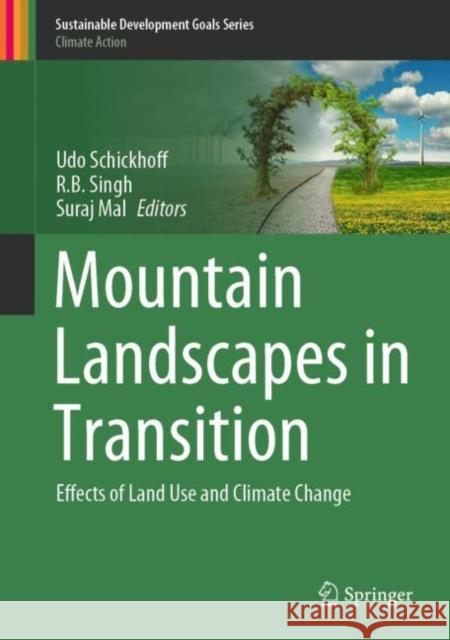Mountain Landscapes in Transition: Effects of Land Use and Climate Change » książka



Mountain Landscapes in Transition: Effects of Land Use and Climate Change
ISBN-13: 9783030702373 / Angielski / Twarda / 2021 / 656 str.
Mountain Landscapes in Transition: Effects of Land Use and Climate Change
ISBN-13: 9783030702373 / Angielski / Twarda / 2021 / 656 str.
(netto: 650,21 VAT: 5%)
Najniższa cena z 30 dni: 655,41
ok. 22 dni roboczych
Dostawa w 2026 r.
Darmowa dostawa!
Dedication/Foreword: Bruno Messerli
1. Alpine ecosystems in a changing world (Udo Schickhoff, RB Singh, Suraj Mal)
Section I: Climate change and response processes of mountain environments
2. Anticipated shifting of thermal and moisture boundary under changing climate across Nepal (Rocky Talchabhadel, Ramchandra Karki)
3. Quantifying uncertainties in climate change projection and its impact on water availability in the Thuli Bheri river basin, Nepal (Anil Aryal, Manisha Maharjan, Rocky Talchabhadel)
4. Markers of climate change: analyzing extreme temperature indices over the Himalayan mountains and adjoining Punjab plains (Manu Raj Sharma, Vishwa B. S. Chandel, Karanjot Kaur Brar)
5. Spatio-temporal distribution of precipitation in the Himalayan region using TRMM satellite data (Nitu Singh, Sharad Kumar Gupta, C.S. Dubey, Dericks P. Shukla)
6. Spatial variations and long-term trends of rainfall across Uttarakhand Himalaya, India (Suraj Mal, Manohar Arora, Abhishek Banerjee, RB Singh, Christopher A. Scott, SK Allen, Ramchandra Karki)
7. Spatio-temporal heterogeneity in glaciers response across Western Himalaya (Saurabh Kaushika, P.K. Joshi, Tejpal Singh, Mohd. Farooq Azam)
8. Temporal variability of the Satopanth glacier facies at sub-pixel scale, Garhwal Himalaya, India (Bisma Yousuf, Aparna Shukla, MK Arora)
9. Decreasing water availability as a threat for traditional irrigation-based land-use systems in the Mustang Himalaya/Nepal (Jussi Grießinger, Wolfgang J.H. Meier, Philipp Hochreuther)
10. Glaciers, climate, and people: Holocene transitions in the Stubai Valley (Andrea Fischer, Lucia Felbauer, Andrina Jaenicke, Kay Helfricht, Helene Hoffmann, Eva-Maria Wild)
11. Environmental and socio-economic consequences of recent mountain glacier fluctuations in Norway (Philipp Marr, Stefan Winkler, Jörg Löffler)
12. Distance from retreating snowfields influences alpine plant functional traits at Glacier National Park, Montana (Martha E. Apple, Macy K. Ricketts, Alice C. Martin, Dennis J. Moritz)
13. Environmental drivers of species composition and tree species density of a near-natural Himalayan treeline ecotone. Implications for the response to climate change (Niels Schwab, Birgit Bürzle, Jürgen Böhner, Ram Prasad Chaudhary, Thomas Scholten, Udo Schickhoff)14. Modelling the ecological niche of a treeline tree species (Betula utilis) in the Himalayas - a methodological overview (Maria Bobrowski)
15. Changing climate scenario in high altitude regions: Comparison of observed trends and perceptions of agro-pastoralists in Darma Valley, Uttarakhand, India (Deepika Rawat, Udo Schickhoff)
16. Conifer growth during warming hiatus in the Altay-Sayan Mountain Region, Siberia (Viacheslav I. Kharuk, Sergei T. Im, Il’ya A. Petrov)
17. Climate-induced fir (Abies sibirica Ledeb.) mortality in the Siberian Mountains (Viacheslav I. Kharuk, Sergei T. Im, Il’ya A. Petrov, Alexander S. Shushpanov and Maria L. Dvinskaya)
18. Climate change and dynamics of vegetation in the Lesser Caucasus: An overview (George Fayvush, Alla Aleksanyan)
19. Paraglacial time scale and sediment fluxes for hillslope land systems in the northern Appalachian Mountains of Eastern Canada (Daniel Germain, Ludwig Stabile-Caille)
Section II: Response processes of mountain environments to land use change
20. Dynamics of land use/land cover changes in Mizoram, eastern extension of the Himalaya (VP Sati)
21. Urbanization in the Himalayas - An interregional perspective to land use and urban growth dynamics (P.K. Joshi)
22. Assessment and prediction of land use/land cover changes of Beas Basin using a modelling approach (Seema Rani, S Sreekesh)
23. Changing scenario of tropical forests due to shifting cultivation in the Indo-Burman biogeographical hotspot: A study on three hill ranges of Tripura, northeast India (Jatan Debnath, Nibedita Das (Pan), Amal Debnath, Istak Ahmed)24. History of vegetation and land use change in the northern limestone Alps with special reference to the Zugspitzplatt (Wetterstein Mts., Bavaria, Germany) (Arne Friedmann, Philipp Stojakowits, Oliver Korch)
25. Mountain pastures of Qilian Shan under continuous grazing: Main environmental gradients, vegetation composition and soil properties (Alina Baranova, Udo Schickhoff) 26. Mountain habitats dynamics under changing grazing management schemes (Michael Vrahnakis, Yannis Kazoglou)27. Assessing the impact of climate change versus land use on tree- and forest line dynamics in Norway (Anders Bryn, Kerstin Potthoff)
28. Landscape dynamics in the northwestern mountains of the Iberian Peninsula: Case study Ancares-Courel Range (Ignacio J. Diaz-Maroto)
29. The changing landscape of the plantation sector in the Central Highlands of Sri Lanka (Mahendra Peiris, A D Nuwan Gunarathne)
30. Social-ecological misalignments threaten mountain water tower resilience in Utah, U.S.A. (Courtney Flint, Michelle Baker)31. Current crisis and future woes: The case of climate change in the Drakensberg Mountains region of southern Africa and its socio-economic impacts (Geoffrey Mukwada)
32. Changing paradigm in transboundary landscape management> A retrospect from the Hindu Kush Himalaya. (Nakul Chettri, Srihana Joshi, Bandana Shakya, Sunita Chaudhary, Lipy Adhikari, Nabin Bhattarai, Eklabys Sharma, and Devid Molden).
This book compiles available knowledge of the response of mountain ecosystems to recent climate and land use change and intends to bridge the gap between science, policy and the community concerned.
The chapters present key concepts, major drivers and key processes of mountain response, providing transdisciplinary orientation to mountain studies incorporating experiences of academics, community leaders and policy-makers from developed and less developed countries. The book chapters are arranged in two sections. The first section concerns the response processes of mountain environments to climate change. This section addresses climate change itself (past, current and future changes of temperature and precipitation) and its impacts on the cryosphere, hydrosphere, biosphere, and human-environment systems.The second section focuses on the response processes of mountain environments to land use/land cover change. The case studies address effects of changing agriculture and pastoralism, forest/water resources management and urbanization processes, landscape management, and biodiversity conservation.
The book is designed as an interdisciplinary publication which critically evaluates developments in mountains of the world with contributions from both social and natural sciences.
1997-2025 DolnySlask.com Agencja Internetowa
KrainaKsiazek.PL - Księgarnia Internetowa









